Business Process Analysis and Change for Ballarat Dentistry
VerifiedAdded on 2021/05/27
|10
|1719
|82
Report
AI Summary
This report provides a comprehensive analysis of business process analytics and change management, focusing on the case of Ballarat Dentistry. It begins with an introduction to business process management, highlighting its importance in ensuring reproducible results and capitalizing on growth opportunities. The report then delves into business process modeling, exploring process categorization models, capability maturity models, and the use of a case function matrix. Specific models for the examination and registration processes at Ballarat Dentistry are presented, along with discussions on 7PMG guidelines and cycle time calculations. Furthermore, the report proposes redesign strategies for both the examination and registration processes, aiming to improve efficiency and effectiveness. The architecture of a Business Process Management System (BPMS) is also discussed. The conclusion emphasizes the importance of aligning process changes with the business's mission and vision, as well as the need to reduce cycle times through efficient processes.
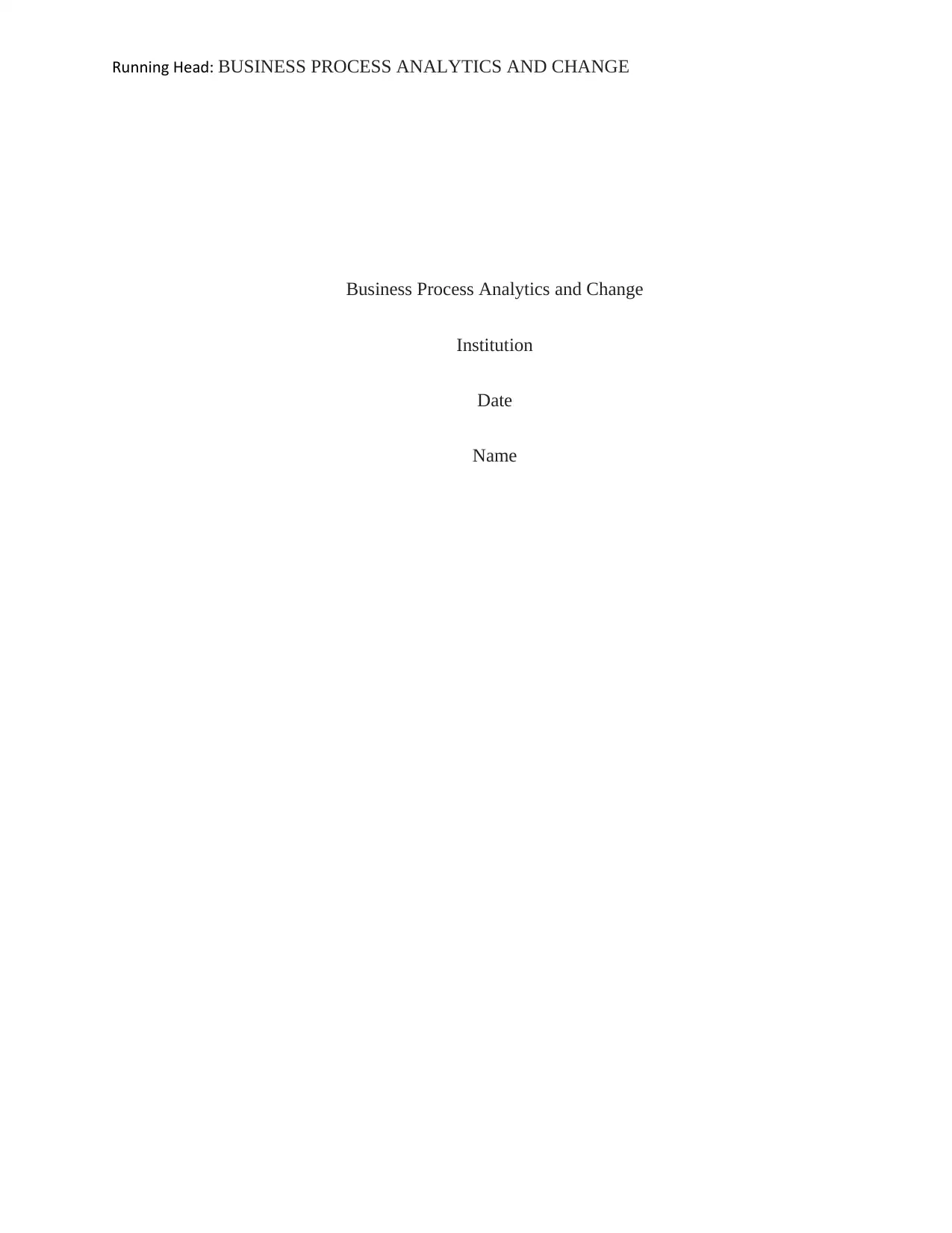
1Running Head: BUSINESS PROCESS ANALYTICS AND CHANGE
Business Process Analytics and Change
Institution
Date
Name
Business Process Analytics and Change
Institution
Date
Name
Paraphrase This Document
Need a fresh take? Get an instant paraphrase of this document with our AI Paraphraser
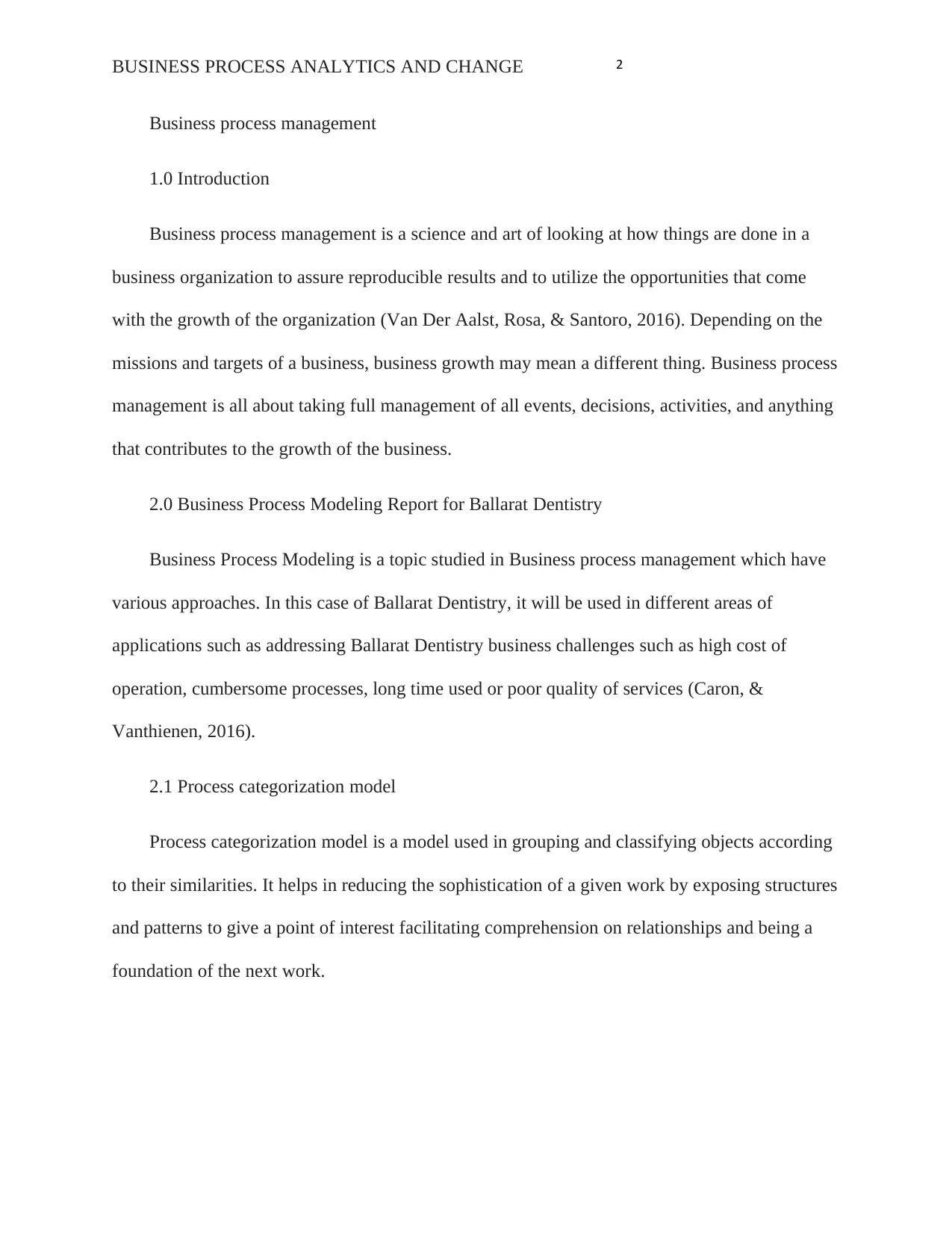
2BUSINESS PROCESS ANALYTICS AND CHANGE
Business process management
1.0 Introduction
Business process management is a science and art of looking at how things are done in a
business organization to assure reproducible results and to utilize the opportunities that come
with the growth of the organization (Van Der Aalst, Rosa, & Santoro, 2016). Depending on the
missions and targets of a business, business growth may mean a different thing. Business process
management is all about taking full management of all events, decisions, activities, and anything
that contributes to the growth of the business.
2.0 Business Process Modeling Report for Ballarat Dentistry
Business Process Modeling is a topic studied in Business process management which have
various approaches. In this case of Ballarat Dentistry, it will be used in different areas of
applications such as addressing Ballarat Dentistry business challenges such as high cost of
operation, cumbersome processes, long time used or poor quality of services (Caron, &
Vanthienen, 2016).
2.1 Process categorization model
Process categorization model is a model used in grouping and classifying objects according
to their similarities. It helps in reducing the sophistication of a given work by exposing structures
and patterns to give a point of interest facilitating comprehension on relationships and being a
foundation of the next work.
Business process management
1.0 Introduction
Business process management is a science and art of looking at how things are done in a
business organization to assure reproducible results and to utilize the opportunities that come
with the growth of the organization (Van Der Aalst, Rosa, & Santoro, 2016). Depending on the
missions and targets of a business, business growth may mean a different thing. Business process
management is all about taking full management of all events, decisions, activities, and anything
that contributes to the growth of the business.
2.0 Business Process Modeling Report for Ballarat Dentistry
Business Process Modeling is a topic studied in Business process management which have
various approaches. In this case of Ballarat Dentistry, it will be used in different areas of
applications such as addressing Ballarat Dentistry business challenges such as high cost of
operation, cumbersome processes, long time used or poor quality of services (Caron, &
Vanthienen, 2016).
2.1 Process categorization model
Process categorization model is a model used in grouping and classifying objects according
to their similarities. It helps in reducing the sophistication of a given work by exposing structures
and patterns to give a point of interest facilitating comprehension on relationships and being a
foundation of the next work.
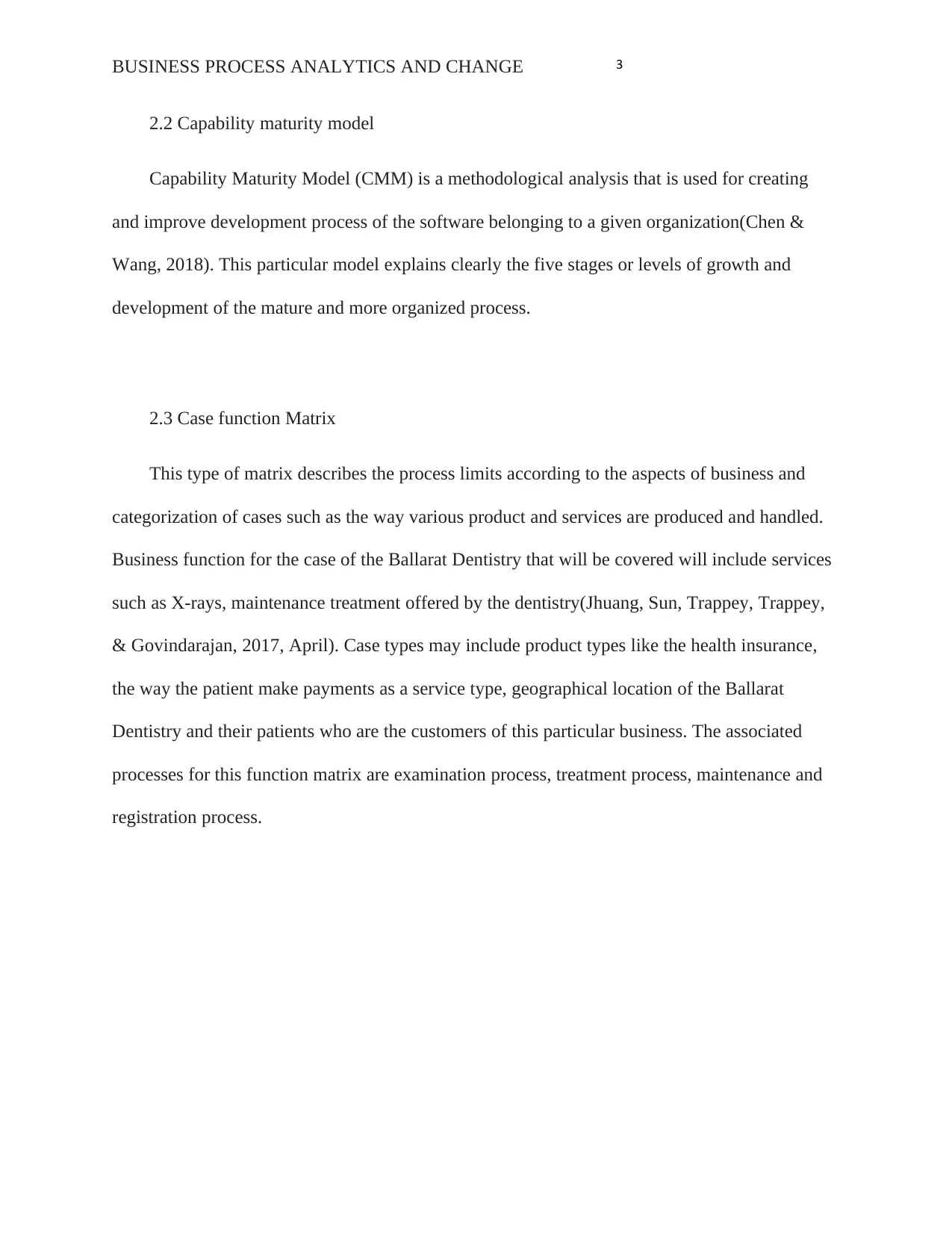
3BUSINESS PROCESS ANALYTICS AND CHANGE
2.2 Capability maturity model
Capability Maturity Model (CMM) is a methodological analysis that is used for creating
and improve development process of the software belonging to a given organization(Chen &
Wang, 2018). This particular model explains clearly the five stages or levels of growth and
development of the mature and more organized process.
2.3 Case function Matrix
This type of matrix describes the process limits according to the aspects of business and
categorization of cases such as the way various product and services are produced and handled.
Business function for the case of the Ballarat Dentistry that will be covered will include services
such as X-rays, maintenance treatment offered by the dentistry(Jhuang, Sun, Trappey, Trappey,
& Govindarajan, 2017, April). Case types may include product types like the health insurance,
the way the patient make payments as a service type, geographical location of the Ballarat
Dentistry and their patients who are the customers of this particular business. The associated
processes for this function matrix are examination process, treatment process, maintenance and
registration process.
2.2 Capability maturity model
Capability Maturity Model (CMM) is a methodological analysis that is used for creating
and improve development process of the software belonging to a given organization(Chen &
Wang, 2018). This particular model explains clearly the five stages or levels of growth and
development of the mature and more organized process.
2.3 Case function Matrix
This type of matrix describes the process limits according to the aspects of business and
categorization of cases such as the way various product and services are produced and handled.
Business function for the case of the Ballarat Dentistry that will be covered will include services
such as X-rays, maintenance treatment offered by the dentistry(Jhuang, Sun, Trappey, Trappey,
& Govindarajan, 2017, April). Case types may include product types like the health insurance,
the way the patient make payments as a service type, geographical location of the Ballarat
Dentistry and their patients who are the customers of this particular business. The associated
processes for this function matrix are examination process, treatment process, maintenance and
registration process.
⊘ This is a preview!⊘
Do you want full access?
Subscribe today to unlock all pages.

Trusted by 1+ million students worldwide
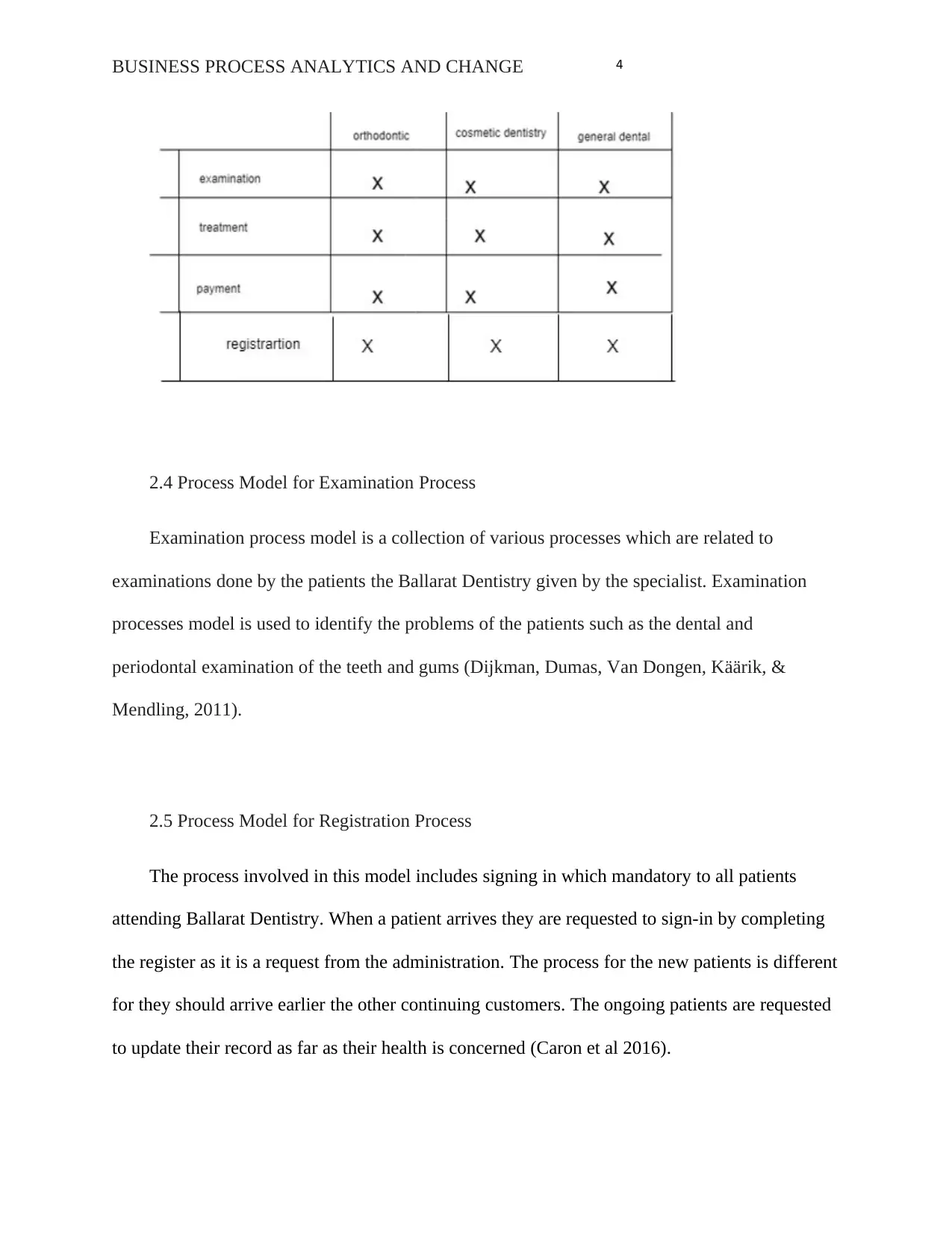
4BUSINESS PROCESS ANALYTICS AND CHANGE
2.4 Process Model for Examination Process
Examination process model is a collection of various processes which are related to
examinations done by the patients the Ballarat Dentistry given by the specialist. Examination
processes model is used to identify the problems of the patients such as the dental and
periodontal examination of the teeth and gums (Dijkman, Dumas, Van Dongen, Käärik, &
Mendling, 2011).
2.5 Process Model for Registration Process
The process involved in this model includes signing in which mandatory to all patients
attending Ballarat Dentistry. When a patient arrives they are requested to sign-in by completing
the register as it is a request from the administration. The process for the new patients is different
for they should arrive earlier the other continuing customers. The ongoing patients are requested
to update their record as far as their health is concerned (Caron et al 2016).
2.4 Process Model for Examination Process
Examination process model is a collection of various processes which are related to
examinations done by the patients the Ballarat Dentistry given by the specialist. Examination
processes model is used to identify the problems of the patients such as the dental and
periodontal examination of the teeth and gums (Dijkman, Dumas, Van Dongen, Käärik, &
Mendling, 2011).
2.5 Process Model for Registration Process
The process involved in this model includes signing in which mandatory to all patients
attending Ballarat Dentistry. When a patient arrives they are requested to sign-in by completing
the register as it is a request from the administration. The process for the new patients is different
for they should arrive earlier the other continuing customers. The ongoing patients are requested
to update their record as far as their health is concerned (Caron et al 2016).
Paraphrase This Document
Need a fresh take? Get an instant paraphrase of this document with our AI Paraphraser
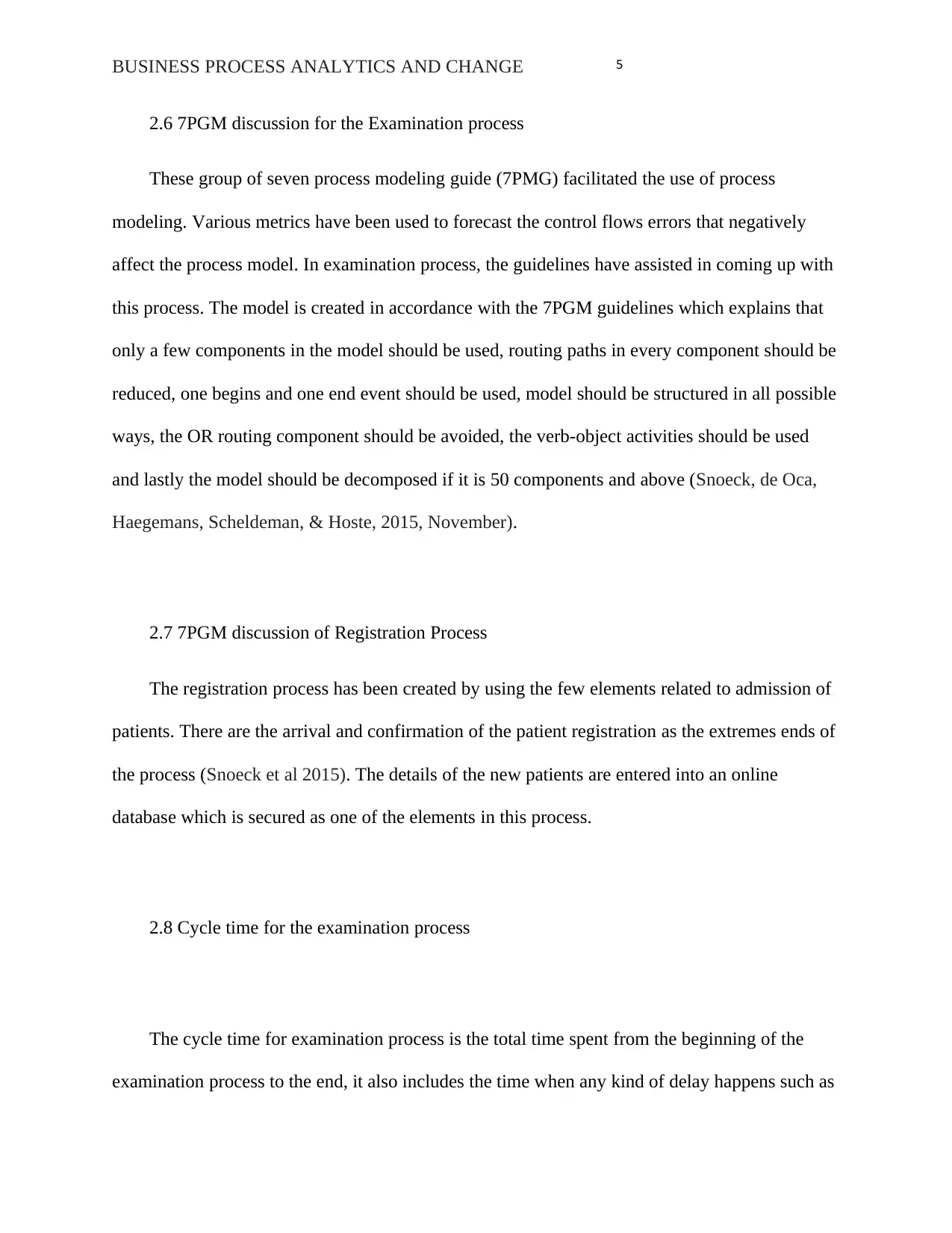
5BUSINESS PROCESS ANALYTICS AND CHANGE
2.6 7PGM discussion for the Examination process
These group of seven process modeling guide (7PMG) facilitated the use of process
modeling. Various metrics have been used to forecast the control flows errors that negatively
affect the process model. In examination process, the guidelines have assisted in coming up with
this process. The model is created in accordance with the 7PGM guidelines which explains that
only a few components in the model should be used, routing paths in every component should be
reduced, one begins and one end event should be used, model should be structured in all possible
ways, the OR routing component should be avoided, the verb-object activities should be used
and lastly the model should be decomposed if it is 50 components and above (Snoeck, de Oca,
Haegemans, Scheldeman, & Hoste, 2015, November).
2.7 7PGM discussion of Registration Process
The registration process has been created by using the few elements related to admission of
patients. There are the arrival and confirmation of the patient registration as the extremes ends of
the process (Snoeck et al 2015). The details of the new patients are entered into an online
database which is secured as one of the elements in this process.
2.8 Cycle time for the examination process
The cycle time for examination process is the total time spent from the beginning of the
examination process to the end, it also includes the time when any kind of delay happens such as
2.6 7PGM discussion for the Examination process
These group of seven process modeling guide (7PMG) facilitated the use of process
modeling. Various metrics have been used to forecast the control flows errors that negatively
affect the process model. In examination process, the guidelines have assisted in coming up with
this process. The model is created in accordance with the 7PGM guidelines which explains that
only a few components in the model should be used, routing paths in every component should be
reduced, one begins and one end event should be used, model should be structured in all possible
ways, the OR routing component should be avoided, the verb-object activities should be used
and lastly the model should be decomposed if it is 50 components and above (Snoeck, de Oca,
Haegemans, Scheldeman, & Hoste, 2015, November).
2.7 7PGM discussion of Registration Process
The registration process has been created by using the few elements related to admission of
patients. There are the arrival and confirmation of the patient registration as the extremes ends of
the process (Snoeck et al 2015). The details of the new patients are entered into an online
database which is secured as one of the elements in this process.
2.8 Cycle time for the examination process
The cycle time for examination process is the total time spent from the beginning of the
examination process to the end, it also includes the time when any kind of delay happens such as
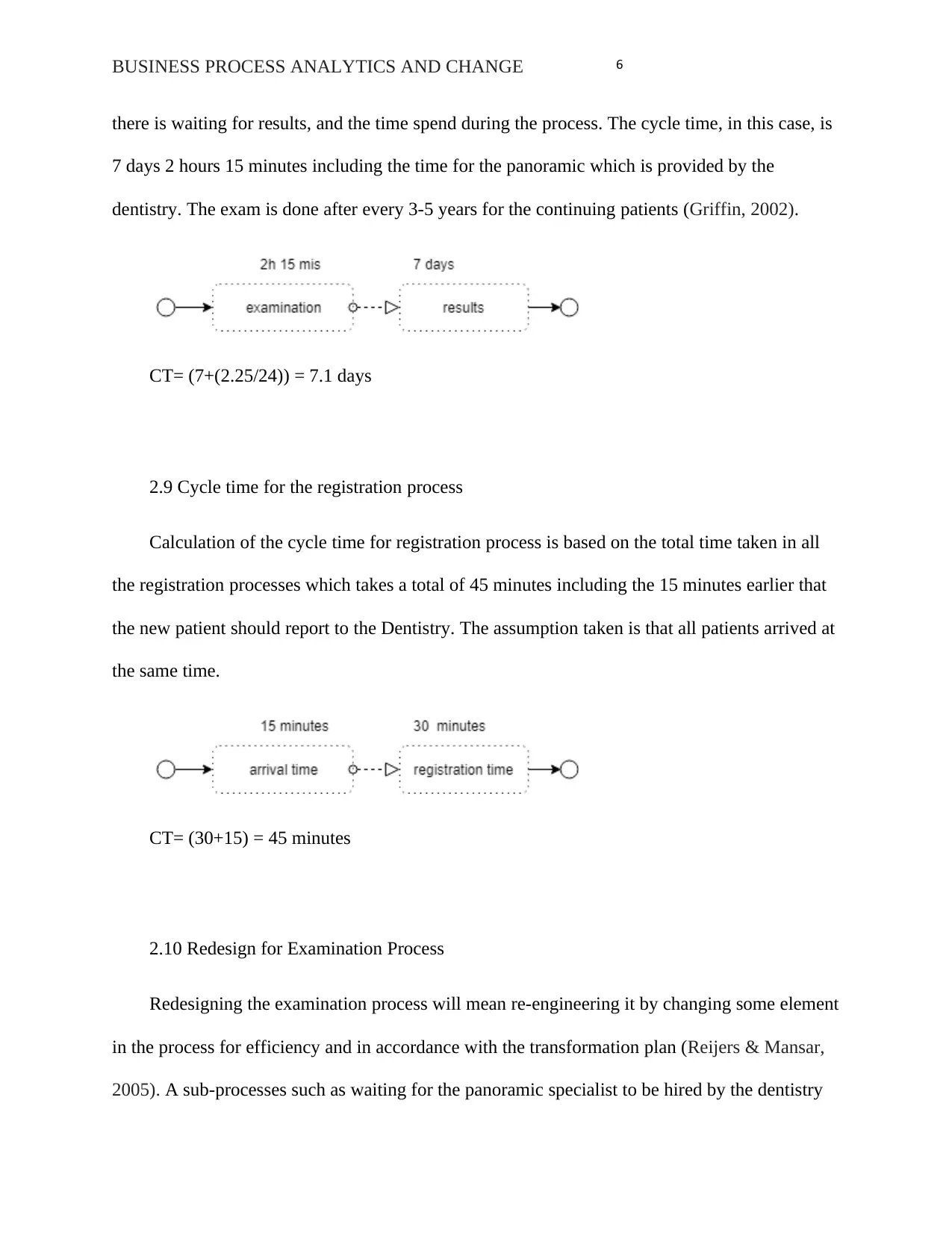
6BUSINESS PROCESS ANALYTICS AND CHANGE
there is waiting for results, and the time spend during the process. The cycle time, in this case, is
7 days 2 hours 15 minutes including the time for the panoramic which is provided by the
dentistry. The exam is done after every 3-5 years for the continuing patients (Griffin, 2002).
CT= (7+(2.25/24)) = 7.1 days
2.9 Cycle time for the registration process
Calculation of the cycle time for registration process is based on the total time taken in all
the registration processes which takes a total of 45 minutes including the 15 minutes earlier that
the new patient should report to the Dentistry. The assumption taken is that all patients arrived at
the same time.
CT= (30+15) = 45 minutes
2.10 Redesign for Examination Process
Redesigning the examination process will mean re-engineering it by changing some element
in the process for efficiency and in accordance with the transformation plan (Reijers & Mansar,
2005). A sub-processes such as waiting for the panoramic specialist to be hired by the dentistry
there is waiting for results, and the time spend during the process. The cycle time, in this case, is
7 days 2 hours 15 minutes including the time for the panoramic which is provided by the
dentistry. The exam is done after every 3-5 years for the continuing patients (Griffin, 2002).
CT= (7+(2.25/24)) = 7.1 days
2.9 Cycle time for the registration process
Calculation of the cycle time for registration process is based on the total time taken in all
the registration processes which takes a total of 45 minutes including the 15 minutes earlier that
the new patient should report to the Dentistry. The assumption taken is that all patients arrived at
the same time.
CT= (30+15) = 45 minutes
2.10 Redesign for Examination Process
Redesigning the examination process will mean re-engineering it by changing some element
in the process for efficiency and in accordance with the transformation plan (Reijers & Mansar,
2005). A sub-processes such as waiting for the panoramic specialist to be hired by the dentistry
⊘ This is a preview!⊘
Do you want full access?
Subscribe today to unlock all pages.

Trusted by 1+ million students worldwide
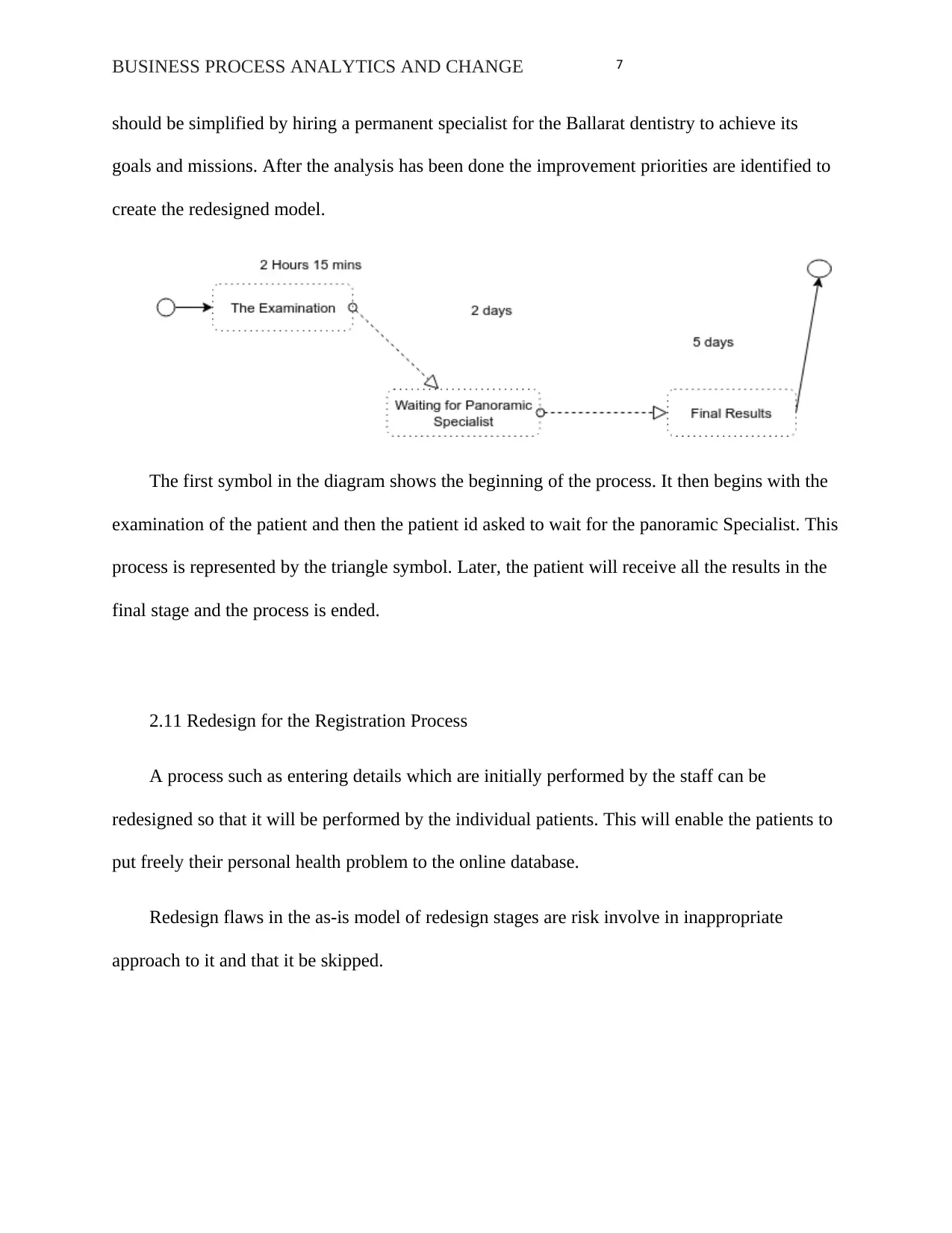
7BUSINESS PROCESS ANALYTICS AND CHANGE
should be simplified by hiring a permanent specialist for the Ballarat dentistry to achieve its
goals and missions. After the analysis has been done the improvement priorities are identified to
create the redesigned model.
The first symbol in the diagram shows the beginning of the process. It then begins with the
examination of the patient and then the patient id asked to wait for the panoramic Specialist. This
process is represented by the triangle symbol. Later, the patient will receive all the results in the
final stage and the process is ended.
2.11 Redesign for the Registration Process
A process such as entering details which are initially performed by the staff can be
redesigned so that it will be performed by the individual patients. This will enable the patients to
put freely their personal health problem to the online database.
Redesign flaws in the as-is model of redesign stages are risk involve in inappropriate
approach to it and that it be skipped.
should be simplified by hiring a permanent specialist for the Ballarat dentistry to achieve its
goals and missions. After the analysis has been done the improvement priorities are identified to
create the redesigned model.
The first symbol in the diagram shows the beginning of the process. It then begins with the
examination of the patient and then the patient id asked to wait for the panoramic Specialist. This
process is represented by the triangle symbol. Later, the patient will receive all the results in the
final stage and the process is ended.
2.11 Redesign for the Registration Process
A process such as entering details which are initially performed by the staff can be
redesigned so that it will be performed by the individual patients. This will enable the patients to
put freely their personal health problem to the online database.
Redesign flaws in the as-is model of redesign stages are risk involve in inappropriate
approach to it and that it be skipped.
Paraphrase This Document
Need a fresh take? Get an instant paraphrase of this document with our AI Paraphraser
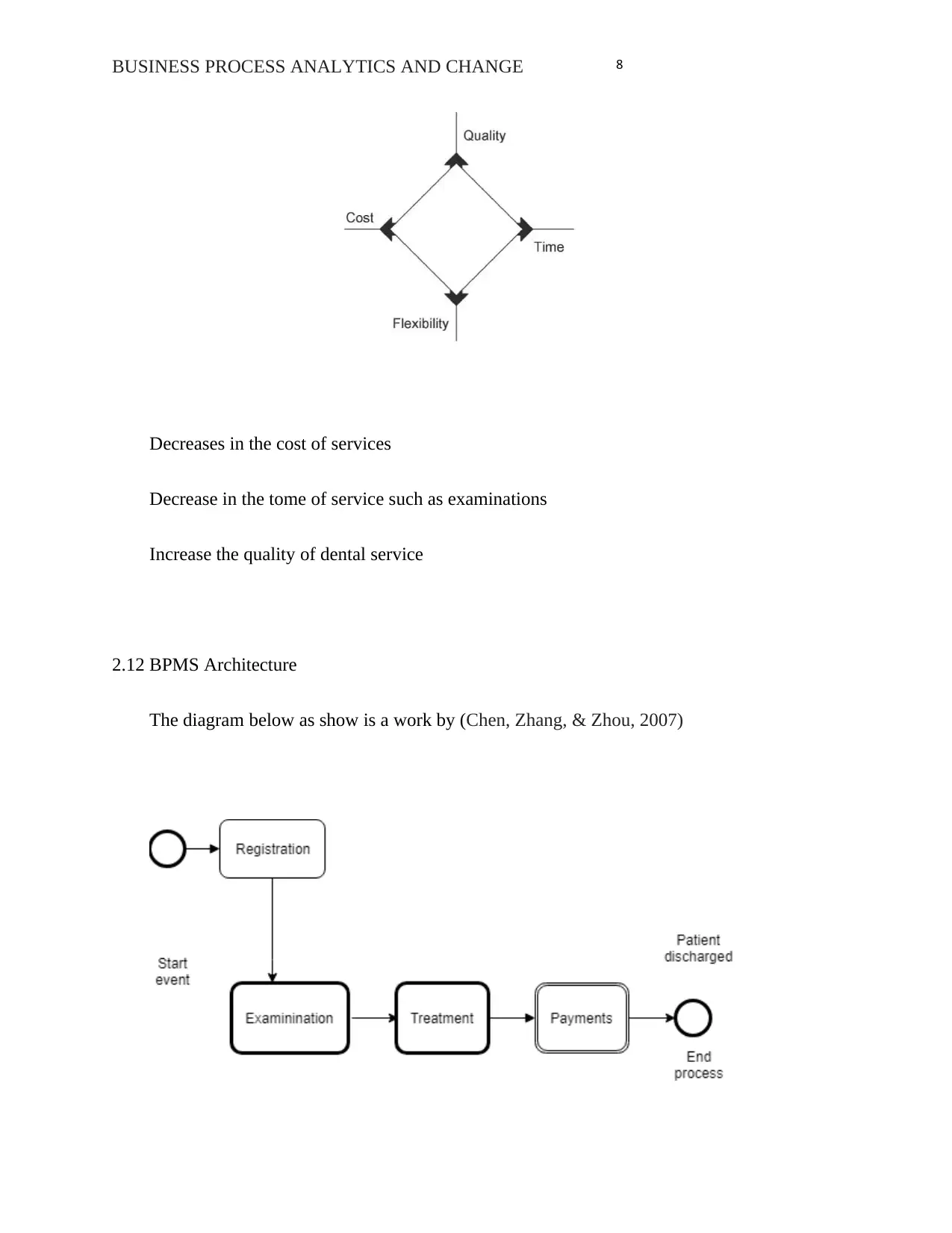
8BUSINESS PROCESS ANALYTICS AND CHANGE
Decreases in the cost of services
Decrease in the tome of service such as examinations
Increase the quality of dental service
2.12 BPMS Architecture
The diagram below as show is a work by (Chen, Zhang, & Zhou, 2007)
Decreases in the cost of services
Decrease in the tome of service such as examinations
Increase the quality of dental service
2.12 BPMS Architecture
The diagram below as show is a work by (Chen, Zhang, & Zhou, 2007)
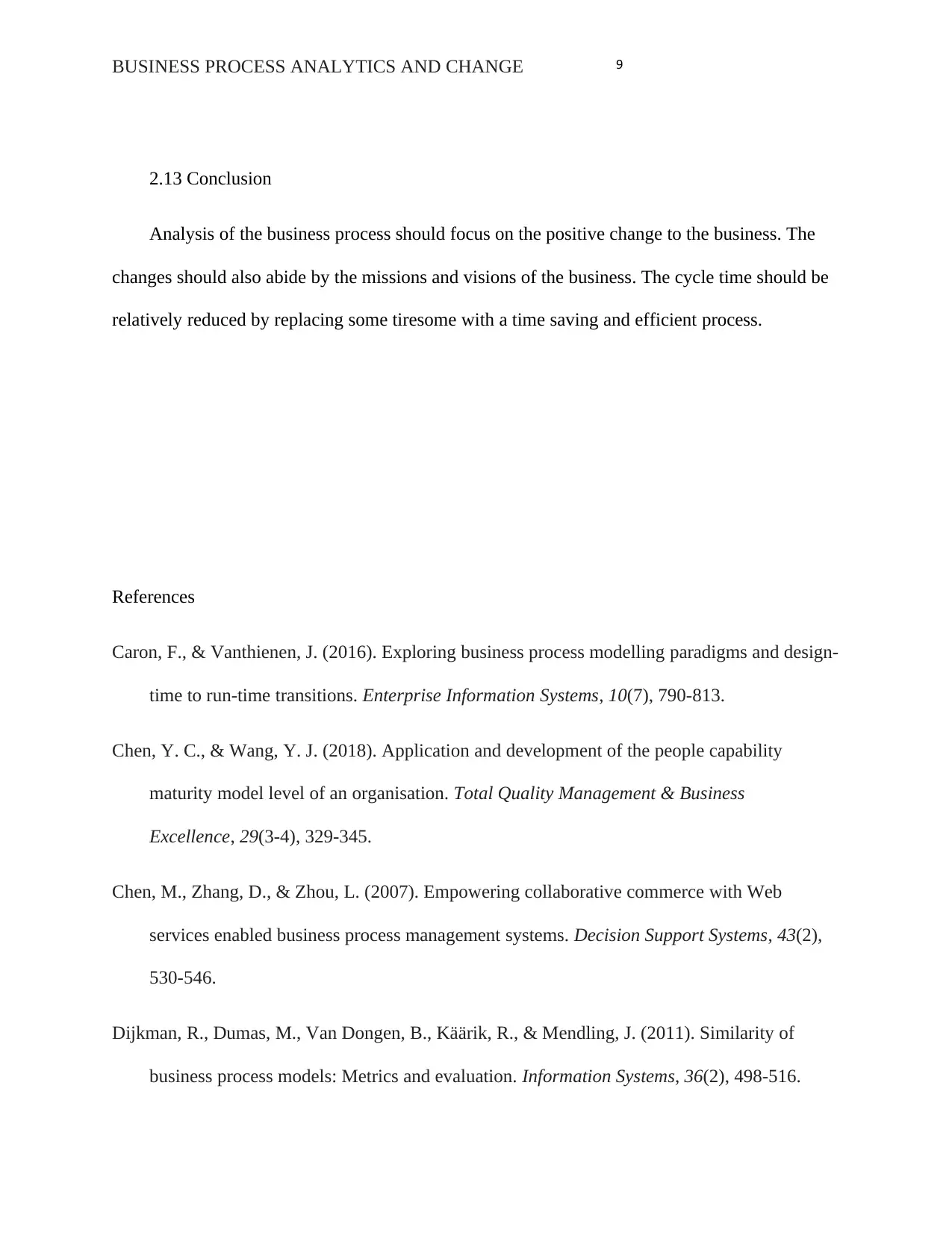
9BUSINESS PROCESS ANALYTICS AND CHANGE
2.13 Conclusion
Analysis of the business process should focus on the positive change to the business. The
changes should also abide by the missions and visions of the business. The cycle time should be
relatively reduced by replacing some tiresome with a time saving and efficient process.
References
Caron, F., & Vanthienen, J. (2016). Exploring business process modelling paradigms and design-
time to run-time transitions. Enterprise Information Systems, 10(7), 790-813.
Chen, Y. C., & Wang, Y. J. (2018). Application and development of the people capability
maturity model level of an organisation. Total Quality Management & Business
Excellence, 29(3-4), 329-345.
Chen, M., Zhang, D., & Zhou, L. (2007). Empowering collaborative commerce with Web
services enabled business process management systems. Decision Support Systems, 43(2),
530-546.
Dijkman, R., Dumas, M., Van Dongen, B., Käärik, R., & Mendling, J. (2011). Similarity of
business process models: Metrics and evaluation. Information Systems, 36(2), 498-516.
2.13 Conclusion
Analysis of the business process should focus on the positive change to the business. The
changes should also abide by the missions and visions of the business. The cycle time should be
relatively reduced by replacing some tiresome with a time saving and efficient process.
References
Caron, F., & Vanthienen, J. (2016). Exploring business process modelling paradigms and design-
time to run-time transitions. Enterprise Information Systems, 10(7), 790-813.
Chen, Y. C., & Wang, Y. J. (2018). Application and development of the people capability
maturity model level of an organisation. Total Quality Management & Business
Excellence, 29(3-4), 329-345.
Chen, M., Zhang, D., & Zhou, L. (2007). Empowering collaborative commerce with Web
services enabled business process management systems. Decision Support Systems, 43(2),
530-546.
Dijkman, R., Dumas, M., Van Dongen, B., Käärik, R., & Mendling, J. (2011). Similarity of
business process models: Metrics and evaluation. Information Systems, 36(2), 498-516.
⊘ This is a preview!⊘
Do you want full access?
Subscribe today to unlock all pages.

Trusted by 1+ million students worldwide
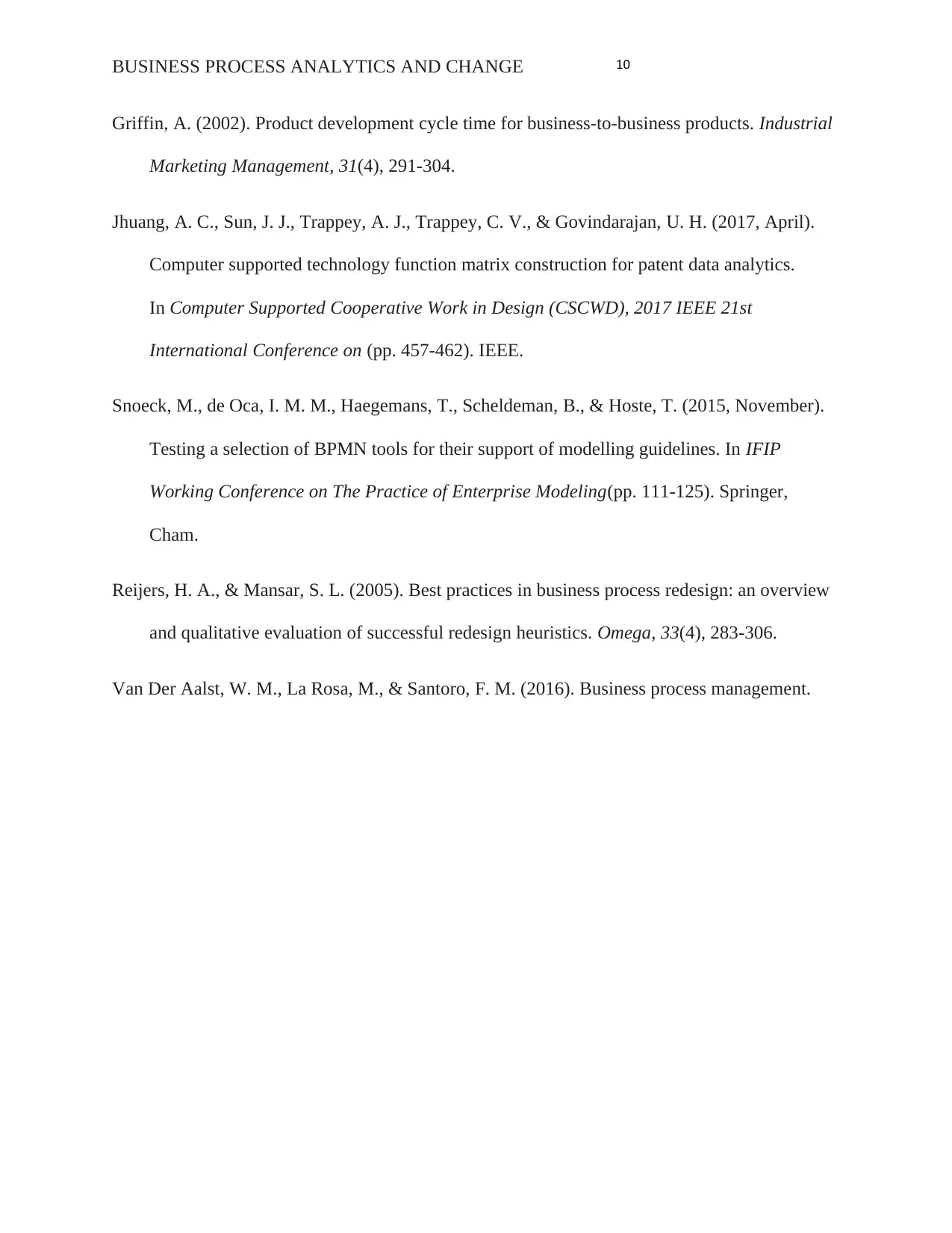
10BUSINESS PROCESS ANALYTICS AND CHANGE
Griffin, A. (2002). Product development cycle time for business-to-business products. Industrial
Marketing Management, 31(4), 291-304.
Jhuang, A. C., Sun, J. J., Trappey, A. J., Trappey, C. V., & Govindarajan, U. H. (2017, April).
Computer supported technology function matrix construction for patent data analytics.
In Computer Supported Cooperative Work in Design (CSCWD), 2017 IEEE 21st
International Conference on (pp. 457-462). IEEE.
Snoeck, M., de Oca, I. M. M., Haegemans, T., Scheldeman, B., & Hoste, T. (2015, November).
Testing a selection of BPMN tools for their support of modelling guidelines. In IFIP
Working Conference on The Practice of Enterprise Modeling(pp. 111-125). Springer,
Cham.
Reijers, H. A., & Mansar, S. L. (2005). Best practices in business process redesign: an overview
and qualitative evaluation of successful redesign heuristics. Omega, 33(4), 283-306.
Van Der Aalst, W. M., La Rosa, M., & Santoro, F. M. (2016). Business process management.
Griffin, A. (2002). Product development cycle time for business-to-business products. Industrial
Marketing Management, 31(4), 291-304.
Jhuang, A. C., Sun, J. J., Trappey, A. J., Trappey, C. V., & Govindarajan, U. H. (2017, April).
Computer supported technology function matrix construction for patent data analytics.
In Computer Supported Cooperative Work in Design (CSCWD), 2017 IEEE 21st
International Conference on (pp. 457-462). IEEE.
Snoeck, M., de Oca, I. M. M., Haegemans, T., Scheldeman, B., & Hoste, T. (2015, November).
Testing a selection of BPMN tools for their support of modelling guidelines. In IFIP
Working Conference on The Practice of Enterprise Modeling(pp. 111-125). Springer,
Cham.
Reijers, H. A., & Mansar, S. L. (2005). Best practices in business process redesign: an overview
and qualitative evaluation of successful redesign heuristics. Omega, 33(4), 283-306.
Van Der Aalst, W. M., La Rosa, M., & Santoro, F. M. (2016). Business process management.
1 out of 10
Related Documents
Your All-in-One AI-Powered Toolkit for Academic Success.
+13062052269
info@desklib.com
Available 24*7 on WhatsApp / Email
![[object Object]](/_next/static/media/star-bottom.7253800d.svg)
Unlock your academic potential
Copyright © 2020–2025 A2Z Services. All Rights Reserved. Developed and managed by ZUCOL.



